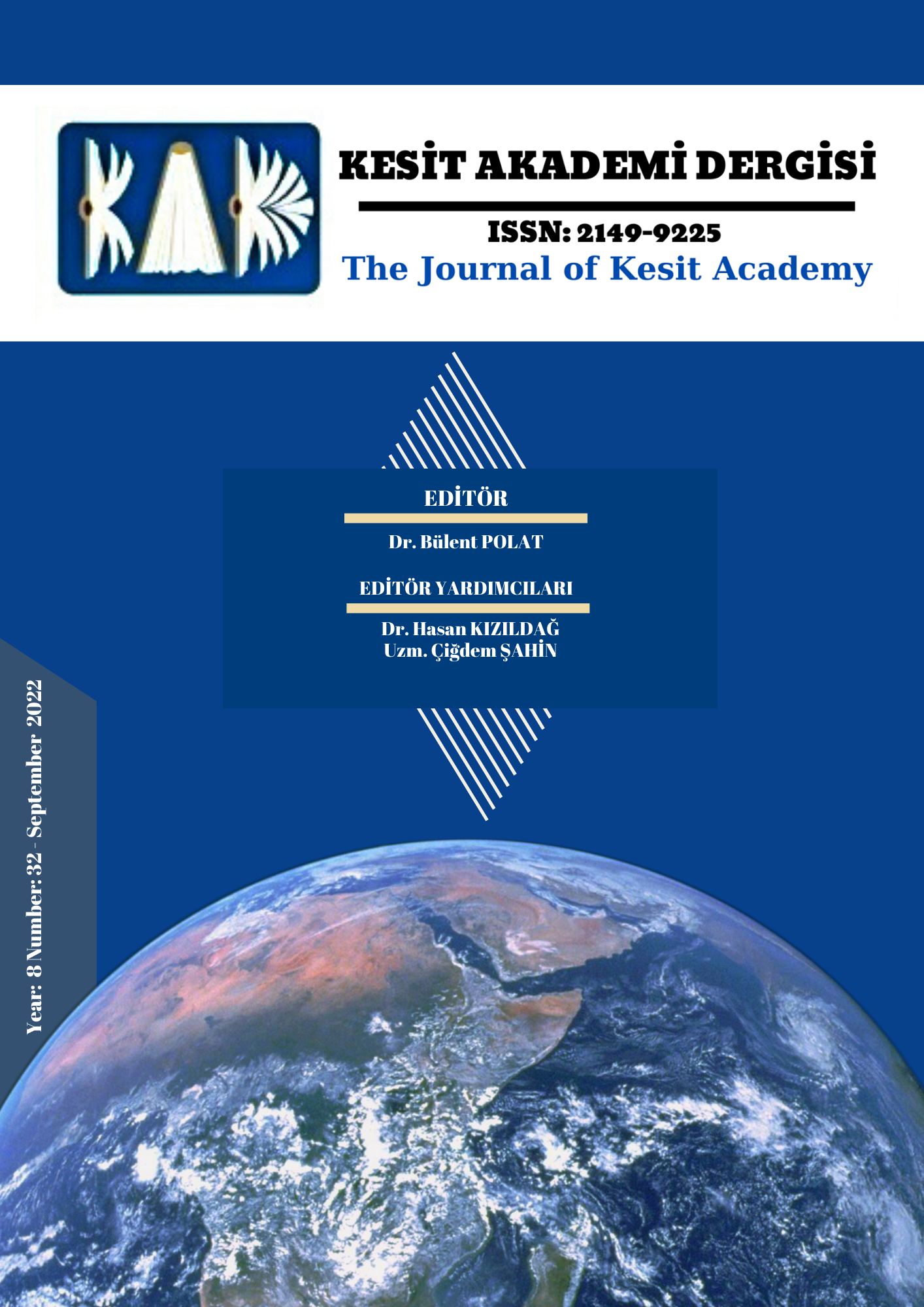Author :
Abstract
- yüzyılda Aydınlanma’yla başlayan, 20. yüzyılın başlarına kadar süren ve küreselleşme ekseninde gelişen modernizm; Batılı toplumların modernizm ve küreselleşme gerçeğini fırsata çevirerek tüm dünyayı kapsayacak kültürel yaşam ve değer yargılarını diğer uluslara yayma gayreti, II. Dünya Savaşı’nın çıkmasıyla sona erer. Soğuk savaş sonrası, özellikle 1960’lara gelindiğinde modernizmin çehresi değişir, bu değişim sanatsal yapılanmalarda da etkisini gösterir. Evrensel olduğunu iddia eden batılı modern sanatın, evrenselin merkezinde kendisinin olduğunu ve bu merkezin dışında kalan kültürlere ait sanatların bu evrensellik içinde yerlerinin olmadığını iddia etmesi üzerine sanatçılar; hiyerarşik modern sanat anlayışını sorgulamış, her kültürden insanın dahil olması gerektiğini savunmuşlardır. Böylece, günümüz sanatında küreselleşme olgusunun iç dinamikleriyle bütün kültürlere kucak açan melez, eklektik, postkolonyal ve çoğulcu demokratik bir yapılanma meydana gelmiştir. Araştırmanın içeriğini oluşturan modernizm-postmodernizm ekseninde küreselleşen estetik, küreselleşmenin iç dinamikleri bağlamında irdelenmiş, ortaya konan veriler geniş bir kaynakça üzerinden ele alınmıştır. Elde edilen bulgular örnek resimlerle açıklanmış, konunun genel bir değerlendirmesi sonuç bölümünde ortaya konmuştur.
Keywords
Abstract
Modernism, which started with the Enlightenment in the 18th century, lasted until the 1950s and developed on the axis of globalization; The effort of Western societies to spread the cultural life and value judgments that will cover the whole world to other nations by turning the reality of modernism and globalization into an opportunity, II. It ends with the outbreak of World War II. After the Cold War, especially when it comes to the 1960s, the face of modernism changes, and this change also shows its effect in artistic structures. After the western modern art, which claims to be universal, claims that it is at the center of the universal and that the arts of cultures outside this center have no place in this universality; They questioned the hierarchical understanding of modern art and argued that people from all cultures should be included. Thus, a hybrid, eclectic, postcolonial and pluralist democratic structure that embraces all cultures with the internal dynamics of the phenomenon of globalization in today's art has emerged. Aesthetics that has become globalized in the axis of modernism-postmodernism, which constitutes the content of the research, has been examined in the context of the internal dynamics of globalization, and the data presented are discussed through a wide bibliography. The findings were explained with sample pictures, and a general evaluation of the subject was presented in the conclusion section.
Keywords
- Barret, T. (2015). Neden bu sanat? Çağdaş sanatta estetik ve eleştiri (Çev.: Esra Ermert). Hayalperest Yayınevi.
- Başkaya, F. (2005). Özgür üniversite kavram sözlüğü: Söylem ve gerçek. Maki Baskı Yayın.
- Bingqin, Cao, Sophia. (2017). Mona Hatoum biografi, Kaynak: https://ocula.com/artists/mona-hatoum/ (Erişim Tarihi: 02.08.2022)
- Çolak, B. (2008). Postmodernizm bağlamında Michel Foucault’nun ahlak anlayışı [Yayın- lanmamış Yüksek Lisans Tezi]. Gazi Üniversitesi, Felsefe Anabilim Dalı.
- Gezgin, S. (2005). Küreselleşmenin medya ve toplum üzerindeki etkileri. İstanbul Üniversitesi İletişim Fakültesi Dergisi, 21, 9-12.
- Giddens, A. (2008). Sosyoloji. Kırmızı Yayınları.
- Güner, B. (2018). Küreselleşme sürecinde sanatta ötekilik *Yayımlanmamış doktora tezi+. Işık Üniversitesi Sosyal Bilimler Enstitüsü.
- Hançerlioğlu, O. (2002). Felsefe sözlüğü. Remzi Kitabevi.
- Held, D. & Mc Grew A. (2008). Küresel dönüşümler büyük küreselleşme tartışması. Phoenix Yayınevi.
- Hopkins, D. (2018). Modern sanattan sonra /1945-2017 (Çev.: Firdevs Candil Erdoğan).
- Kahraman, H. B. (2002). Sanatsal gerçeklikler olgular ve öteleri. Everest Yayınları.
- Mooney, A. ve Evans, B. (2007), Globalization: The Key Concepts, Routledge, Birleşik Krallık.
- Türk Dil Kurumu. (1969). Türkçe Sözlük (genişletilmiş baskı). Türk Dil Kurumu Yayınla- rı.
- Steenwyk, H. ‚Basquiat” http://www.howardsteenwyk.com/basquiat (Erişim Tarihi: 31.07.2022)
- Şahin, H. (2016). Modern sanatta geleneğin reddi . Akademik Sanat, 1 (1), 76-85.
- the-past-and-present/ (Erişim Tarihi: 02.08.2022)
- Yalçınkaya, T. (2010). Küreselleşme sürecinin ekonomi politikaları üzerine etkilerinin analizi: Türkiye örneği *Yayımlanmamış doktora tezi+. Dokuz Eylül Üniversitesi Sosyal Bilimler Enstitüsü İktisat Anabilim Dalı.
- WW Norton, (2016). ‚A collection of critical articles, How to See”, was published by WW Norton in 2016. Kaynak: https://ropac.net/gallery-documents/57/ (Erişim Tarihi: 4.08.2022)
- ‚History of Western Civilization II- Age of Enlightenment‛, Kaynak: https://courses.lumenlearning.com/suny-hccworldhistory/age-of- / (Erişim Tarihi: 6.08.2022)
- Görsel 1. Claude Monet, ‚İzlenim, Gündoğumu‛, Tuval Üzerine Yağlıboya, 1872 Kay- nak: https://tr.wikipedia.org/wiki/%C4%B0zlenimcili Erişim Tarihi: 29.07.2022
- Görsel 2. Jean Dubuffet, ‚Anti-Kültürel Pozisyonlar‛ Tuval Üzerine Karışık Teknik, 1951 Kaynak: https://www.acquavellagalleries.com/Erişim Erişim Tarihi: 31.07,2022
- Görsel 3. Cy Twombly, ‚İsimsiz‛, Kağıt Üzerine Karışık Teknik, 1981
- Kaynak: hhttps://www.invaluable.com/artist/twombly Erişim Tarihi: 31.07.2022 1983 Kaynak: http://www.howardsteenwyk.com/basquiat Erişim Tarihi:
- Kaynak: http://www.artnet.com/artists/shirin-neshat/unveiling-rW7AE_d- XWoA02K2Xugvfg2 Erişim Tarihi: 31.07.2022
- Erişim Tarihi: 1.08.2022
- Kaynak: https://arthur.io/art/masami-teraoka/longing-samurai Erişim Tarihi: 1.08.2022
- migration-and-totemic-gestures-79312 Erişim Tarihi: 02.08.2022
- Görsel 10. Yinka Shonibare, ‚Afrika için Scramble‛, Enstalasyon, 2003
- Kaynak: https://edition.cnn.com/style/article/yinka-shonibare-avant-garde- africa/index.html Erişim Tarihi: 02.08.2022
- Kaynak: http://www.dreamideamachine.com/?p=67279Erişim Tarihi: 02.08.2022
- Kaynak: https://proyectoidis.org/mona-hatoum/measures-of-distance-1988-by-mona- hatoum-born-1952/Erişim Tarihi: 02.08.2022 Tablosu‛, Duvara Yapıştırılmış Siyah Kağıt Desenler, 1995
- Kaynak: https://journalpanorama.org/wp-content/uploads/2016/06/Fryd_Fig-3.jpg Eri- şim Tarihi: 02.08.2022
- Tablosu, Atlas Üzerine Karışık Teknik, 2011 Kaynak:
- kentridge-tackles-colonialism-with-a-quiet-anger-20180810-h13sj1.html Erişim Tarihi:
- Dışkısı‛, 2014 Kaynak: https://readartdesk.com/feature/mountains-of-color Eri-





